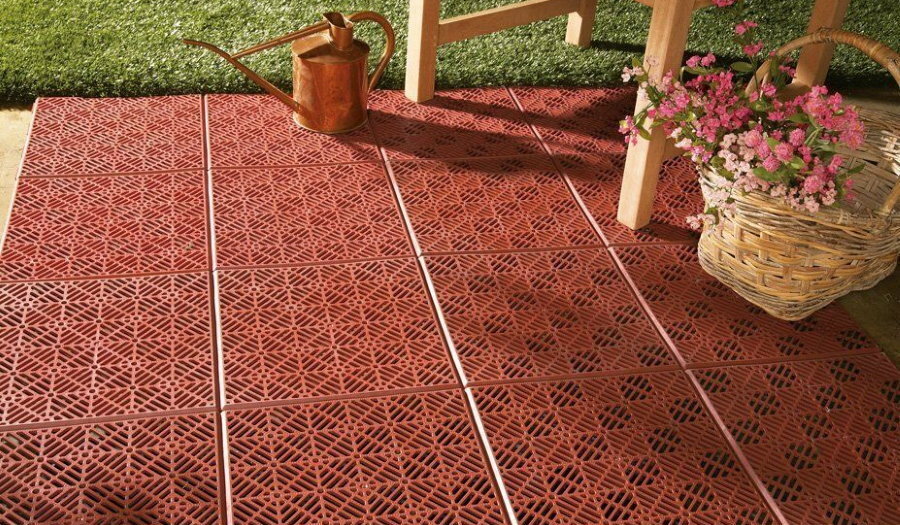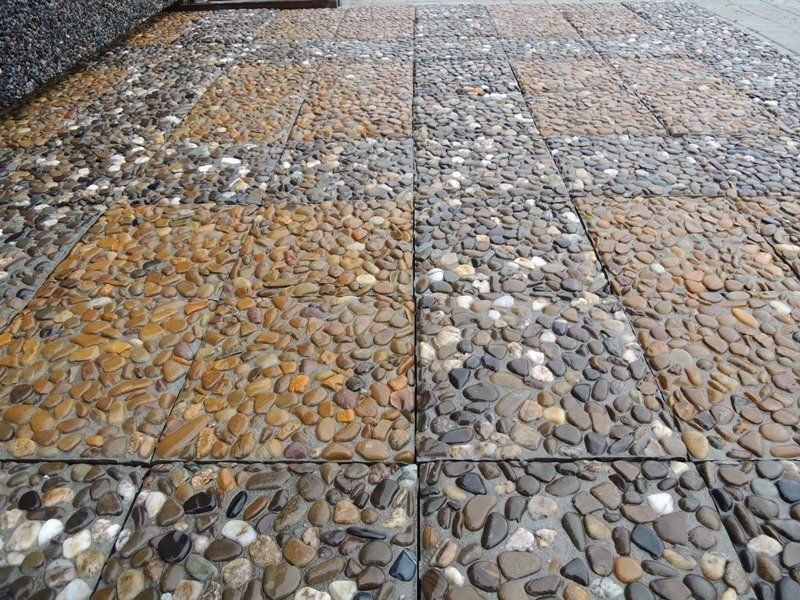At the summer cottage, paths are arranged, convenient for and movement of garden equipment, small paths that provide access to all areas of the garden. Paths in the country house made of paving slabs have the necessary unitary properties, they are convenient and quick to install, if you wish, they can be disassembled for a short time, they can be repaired - replace one tile with another.

Paving slabs are a modern material for arranging paths in a suburban area
Basic rules and common mistakes when choosing paving slabs
Content
- Basic rules and common mistakes when choosing paving slabs
- Choice of material - varieties of tiles
- A natural stone
- Fake diamond
- Concrete
- Polymers and plastics
- Drawings for laying paving slabs and paving stones - design solutions
- Photo examples of beautiful garden paths made of tiles and paving stones
- Video: Technology of laying paving slabs
- Photos of paths from paving slabs in the country
The possible load is determined before purchasing material for paving paths, each paving slab has its own strength. If the thickness of the coating does not correspond to the expected load; type of foundation, cracks and faults will quickly appear. Stone, clinker and concrete tiles are laid on a solid base up to 20 cm thick, depending on the soil. Such materials are afraid of seasonal heaving of the soil. Flexible plastic is thrown directly onto the grass.

The result of poor-quality preparation of the base for paving slabs

Destruction of low-quality tiles under the influence of water and frost
When buying low-quality tiles, there will not be a good result either. When self-manufacturing concrete paving stones or shaped tiles, it is necessary to choose the right brand of cement. From finished products, concrete and stone pavement surfaces have high strength indicators. Ceramics and porcelain stoneware require careful preparation of the substrate. Correctly selected material for any type of installation will last for many years, make movement in the garden convenient and comfortable.

The device of a garden path from paving slabs
In flooded areas where melt and rain water accumulate, drainage is necessary so that puddles do not appear on the paths.
Choice of material - varieties of tiles
For paving garden aisles, materials are chosen depending on the passability. For wide paths where vehicles can pass, strong surfaces are needed. Narrow paths are decorated with light tiles.

Highest quality and most durable track - bounded on both sides by curbs pre-installed on the concrete mix
A natural stone
Stone garden paths are a classic. The stone will fit into any landscape design, it all depends on the shape and color of the stone:
- durable granite with a variety of textures are offered in the form of tiles and bricks;
- marble strikes with a variety of shades, is more often used in the form of natural cuts of blocks;
- slate for laying is chosen hard, quartzite, the palette of shades is wide from gray to marsh, salmon pink to carmine;
- quartzite is harder than shale, rougher, cut to tiles or paving stones;
- shungite is even, smooth, gray as asphalt, sometimes there are pieces with shiny quartz veins;
- sandstone is cut into bars and tiles of various formats, the moisture saturation is higher than that of other stones, but it is very decorative, the rough texture creates an anti-slip effect;
- limestone is quartz rocks that form layered deposits, textured, color from yellow to reddish.

Stone tiles with a relief surface look elegant and expensive
A combination of stones with a rough and smooth surface is allowed. The best option is to lay sandstone and marble together.
Fake diamond
For paving paths in the country, clinker bricks and concrete tiles are used. The clinker is made of plastic clay, it looks like a solid brick, it comes in shades of brown and red-brown.

Clinker paving stones are one of the most durable materials for paths in the country.
Porcelain stoneware differs in texture, color, produced:
- in the form of tiles of various formats;
- torn plates imitating natural pieces of stone.

Most often you can find porcelain stoneware tiles of medium and large formats.

Garden path made of porcelain stoneware tiles with imitation of natural stone
When working with tiled stone, it is recommended to install the curbs on the paths after installation in order to reduce the number of trimmings.
Concrete
Concrete is made smooth or with an anti-slip surface (hardened concrete is treated with sand). Imitate the texture of limestone, clinker. Concrete tile paths in the country are an economical design option. For self-production of fragments, ready-made forms are used.

Concrete tiles are produced in different sizes, textures and thicknesses.

In case of self-production, concrete tiles are poured right on the spot
Polymers and plastics
Modern manufacturers offer many types of decking - artificial deck boards or parquet. Paths made of such tiles look like wooden flooring, they are not afraid of moisture, temperature contrast.

Garden deck or parquet - these are panels with a pattern made from a mixture of plastic and wood flour

The plastic cover of the modules is suitable for the construction of paths and the design of recreation areas
Lawn tile grids are created in the form of modules, they are usually green, easy to install, and will preserve the green carpet.

A plastic lattice path can be made directly across the lawn or laid on a sand cushion and filled with fine gravel
Drawings for laying paving slabs and paving stones - design solutions
There are several types of paving, the laying technology is chosen depending on several factors:
- relief features;
- the width and contour of the track, on a wide one you can create large mosaic patterns, on winding ones, chaotic laying is appropriate;
- architectural features of buildings located on the site;
- the purpose of the zone being drawn up.

Using paving slabs, you can make paths with unusual patterns, different colors and textures
Manufacturers produce tiles in various sizes:
- square;
- hex;
- in the form of fish scales;
- rectangular - this shape is considered traditional.

It is convenient to use paving slabs both on narrow paths and for paving large areas

Paving the recreation area with large-format natural stone tiles

The combination of different tiles allows you to create beautiful patterns on garden paths
Patterns are created by alternating the position of the tiles, using coatings of various colors and sizes.
Errors in marking the site for tiled masonry lead to an increase in the consumption of coatings. The number of tiles to be cut increases.
Typical styling options with step-by-step instructions are easy to find on the Internet:
- Straight laying is the formation of narrow belts that define the direction of travel. In the rows, the seams are combined with adjacent ones or made with a shift by half or 1/3 of the tile.
- "Herringbone" - installation of fragments of the coating at an angle, one of the popular ways of paving paving stones, clinker bricks (changing the angle of the "Christmas tree", visually adjust the width and length of the path).
- A chaotic laying order is encouraged if the tiles in the bundles do not match in shade (before installing the coating, it is recommended to open all purchased packages, only then start laying).
- "Chessboard" - alternation of light and dark fragments. For chess, tiles of any shape are used, the main thing is that they match in size.
- Rhombuses are created for visualization, they are able to stretch and shorten the sidewalk.
- Circles and segments are formed by radial laying, colored square tiles look especially decorative.
- Curly ones are laid out according to a prepared template, they get interesting images of birds and animals, intricate patterns, ornaments.

Herringbone clinker path

Garden paths lined with rectangular tiles "sprawling"
Working with natural stone, picking up pieces for the format of the track, cutting off or chopping off the excess. If desired, smoothen the sharp corners of the stone with a grinder. Fragments are laid end-to-end or with a gap filled with sand or concrete mortar with the addition of dyes. For whiteness, fluff is added, shades of gray are created with ash. Color for water-based emulsion or acrylic paint can be added to concrete.
In the trend, zoning using a combination of natural paving with other types of coatings, the transitions are decorated with different green spaces, complementing a single landscape picture.
Photo examples of beautiful garden paths made of tiles and paving stones
The shape and width of the garden paths depends on the surroundings. In English gardens, the shape of garden paths made of photo or ceramic paving stones is arbitrary, with extensions and contractions. More often they choose a tile with a hexagon and scales that create smooth lines, an original drawing. Beautiful mosaics are created from clinker bars of various shades, colored concrete.

A path of hexagonal tiles in different shades
Natural stone always looks luxurious. Untreated flagstone or layered stone creates a colorful texture in French regular gardens, often featured in fantasy landscaping projects. The elements are laid end-to-end, the gaps filled with tinted concrete add color and emphasize the natural beauty of the stone.

Fusion-style stone tiles at their summer cottage
Garden paths made of figured concrete, decorated with shards, shards of glass, boring jewelry, are always individual, speak of the taste of the owners of the estate. It is more difficult to work with curly tiles, but very interesting drawings are obtained.

Paving slabs with colored pebble decorative coating

Vibrated paving slabs of bright colors
The front walkway will decorate the facade. A winding path between tree trunks or flower beds will visually enlarge the site, create the illusion of spaciousness. You can make the garden more beautiful with any type of coating, the main thing is that the tiles fit harmoniously into the landscape.

The front path, lined with a beautiful pattern, will adequately decorate the entrance area on a suburban area
Video: Technology of laying paving slabs
Photos of paths from paving slabs in the country




